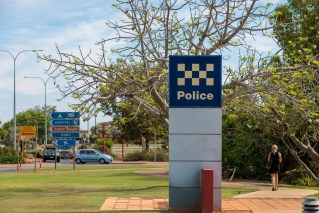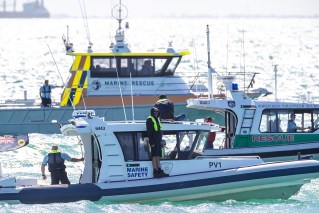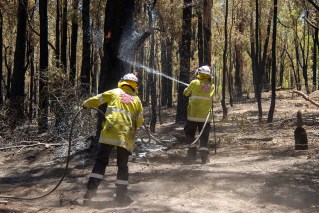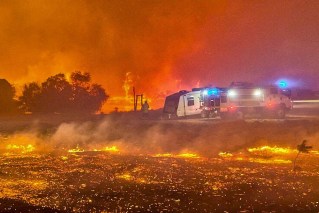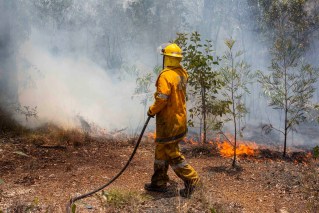‘Should never have been lost’: Big questions after miracle radioactive find

Relieved Western Australian authorities are fending off more questions, after the success of their “needle-in-a-haystack” search for a tiny radioactive capsule.
Search crews defied the odds to find a tiny “Tic-Tac-sized” capsule after it – quite literally – fell off a truck in remote Western Australia.
Emergency Services Minister Stephen Dawson said the discovery was extraordinary considering the scope of the search area.
“Locating this object was a monumental challenge,” he said.
“The search groups have quite literally found the needle in the haystack.”
But questions remain about how the tiny but dangerous object went missing in the first place.
The 8-millimetre by 6-millimetre item fell out of a density gauge while being trucked 1400 kilometres from a Rio Tinto mine in the Pilbara to Perth just over a fortnight ago.

The tiny but deadly capsule was found a couple of metres from the highway. Photo: AAP
Authorities sprang into action, mobilising specialist crews to look for the tiny capsule. Firefighters were diverted from their usual activities and on Tuesday the Australian Radiation Protection and Nuclear Safety Agency said it had sent a team with specialised car-mounted and portable detection equipment to join the search.
On Wednesday, WA government officials said the dangerous capsule had been found just south of Newman – about 200 kilometres from the mine site – on the Great Northern Highway.
It was detected by a vehicle travelling at 70km/h when specialist equipment picked up emitted radiation. Portable detectors were then used to locate it two metres from the side of the road.
Associate Professor Nigel Marks from Western Australia’s Curtin University hailed the find as a “victory for science”.
“You know it emits gamma radiation so the obvious thing is to comb the side of the road looking for something with a strong gamma signal … and sure enough that’s exactly where they found it,” he told the BBC.
Dr Marks added that “orphan sources” – self-contained radioactive material – that get lost are often not recovered.
“A surprisingly large number of these sources that get lost never get found”, he said.
“It’s a regulatory failure, but I think the way they found it is really cool.”
The miracle find came after crews had spent six days scouring the 1400-kilometre route amid warnings the Caesium-137 in the capsule could cause radiation burns or sickness if handled and potentially dangerous levels of radiation with prolonged exposure.
“It emits both beta rays and gamma rays so if you have it close to you, you could either end up with skin damage including skin burns,” WA chief health officer Andy Robertson said.
A government investigation has been launched into the incident and a report will be provided to WA Health Minister Amber-Jade Sanderson.
Rio Tinto has previously apologised and ordered its own review into what went wrong during the haul, which was carried out by a contractor.
The mining giant said a bolt that secured the capsule within the gauge appeared to have sheared off, creating a hole just big enough for the item to escape.
The truck arrived in the Perth suburb of Malaga on January 16. But it wasn’t until nine days later that a technician realised the capsule was missing.
Under WA laws, the maximum fine for failing to safely store or transport radioactive material is just $1000 – a penalty described by Prime Minister Anthony Albanese as “ridiculously low”.
“It shouldn’t have been lost, that’s the first thing. And second, yeah of course that figure is ridiculously low,” he said on Wednesday.
“But I suspect that it’s ridiculously low because people didn’t think that such an item would be lost.”
Ms Sanderson said on Wednesday the state government was looking at increasing the outdated penalty.
“The act which governs the Radiological Council … led by the chief health officer, was actually developed and written in the 1970s,” she said.
“It probably was a lot of money in the 1970s, and this sort of technology wasn’t even imagined.”
The Radiological Council is the regulatory body in charge of investigating how the radioactive capsule was lost.
Rio Tinto iron ore chief executive Simon Trott said the mining giant would fully co-operate with the government’s investigation.
“We’d be happy to reimburse the cost of the search. That is ultimately a matter for the state government,” he said.
Department of Fire and Emergency Services chief executive Darren Klemm said it had been an outstanding collaboration between state and federal agencies.
“Once the capsule has been secured we will survey the site to ensure there is no contamination in the surrounding area,” he said.
“In the extremely unlikely circumstance that the capsule leaked, we will remediate the area.”
Defence officials are verifying the identification of the capsule, which has been placed into a lead container to shield against radiation.
It will be stored in a secure location in Newman before being transported to a Perth health facility.
Dr Robertson said the capsule did not appear to have moved and no injuries had been reported.
-with AAP

